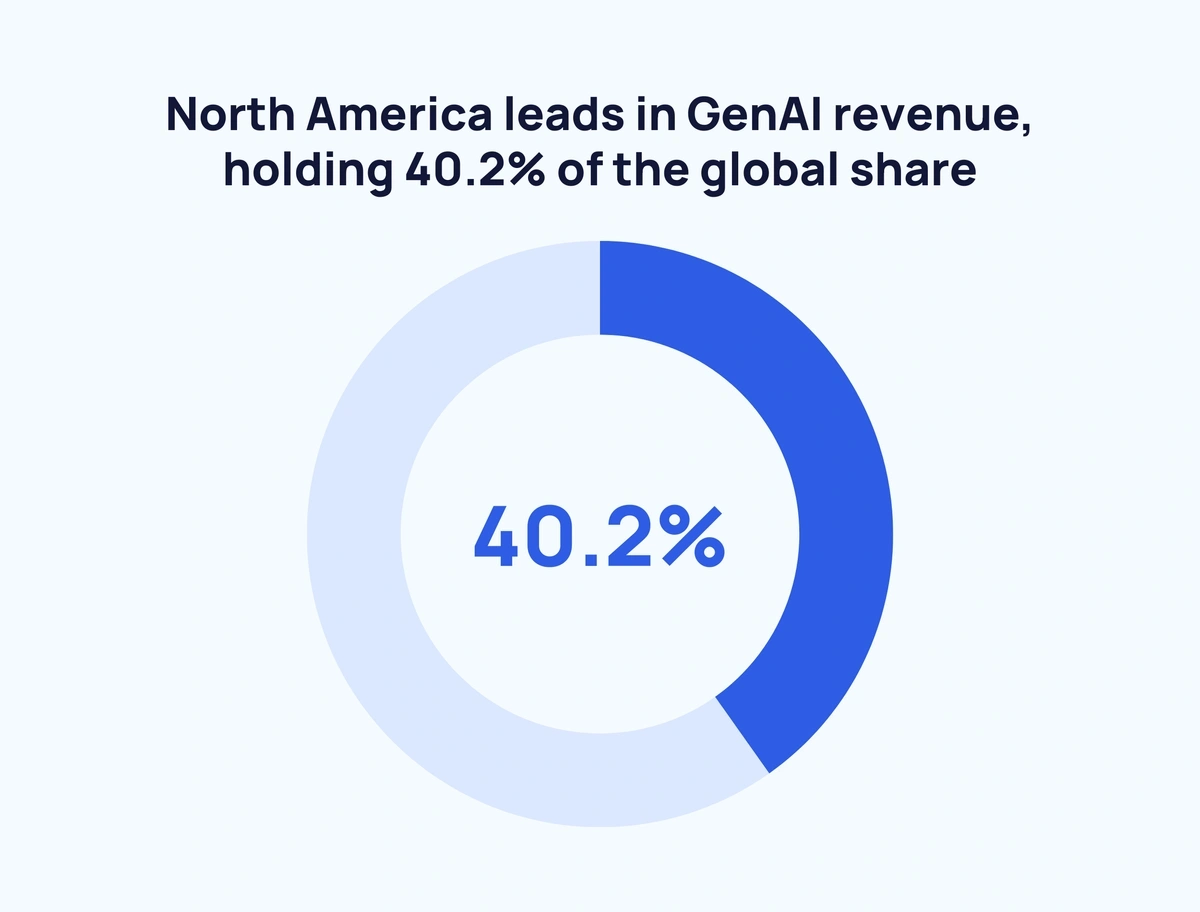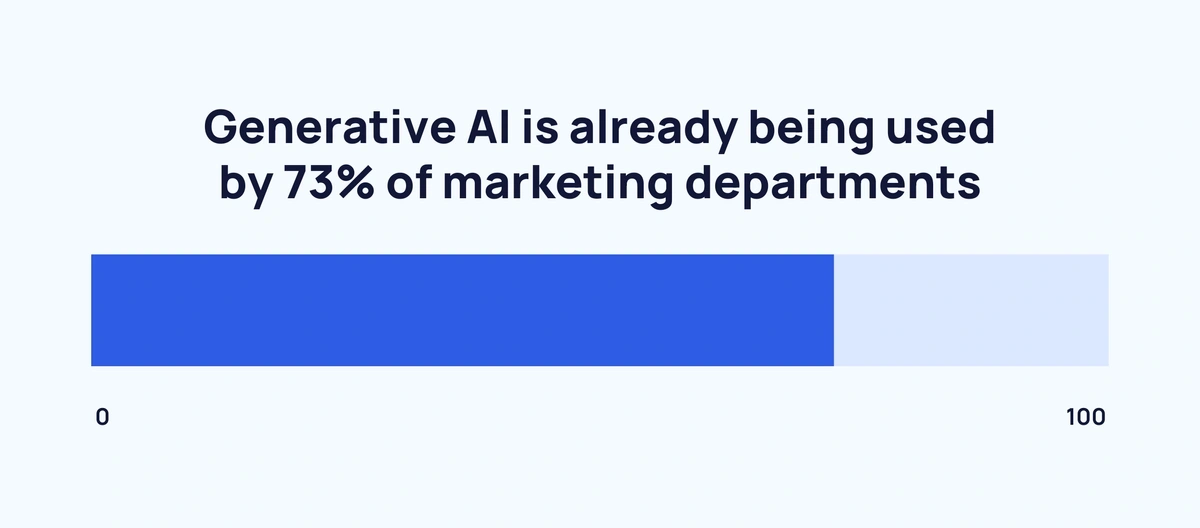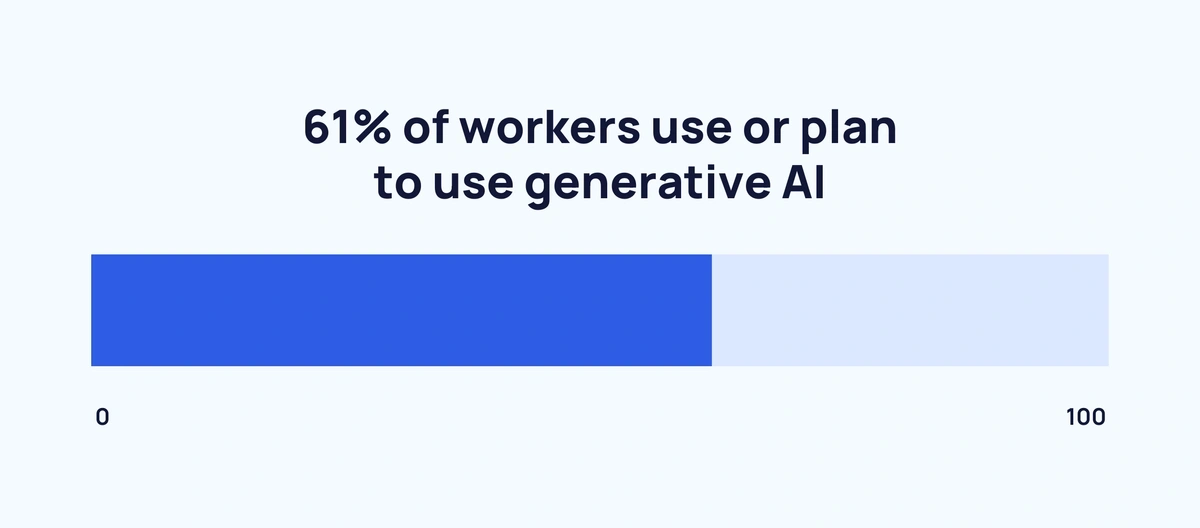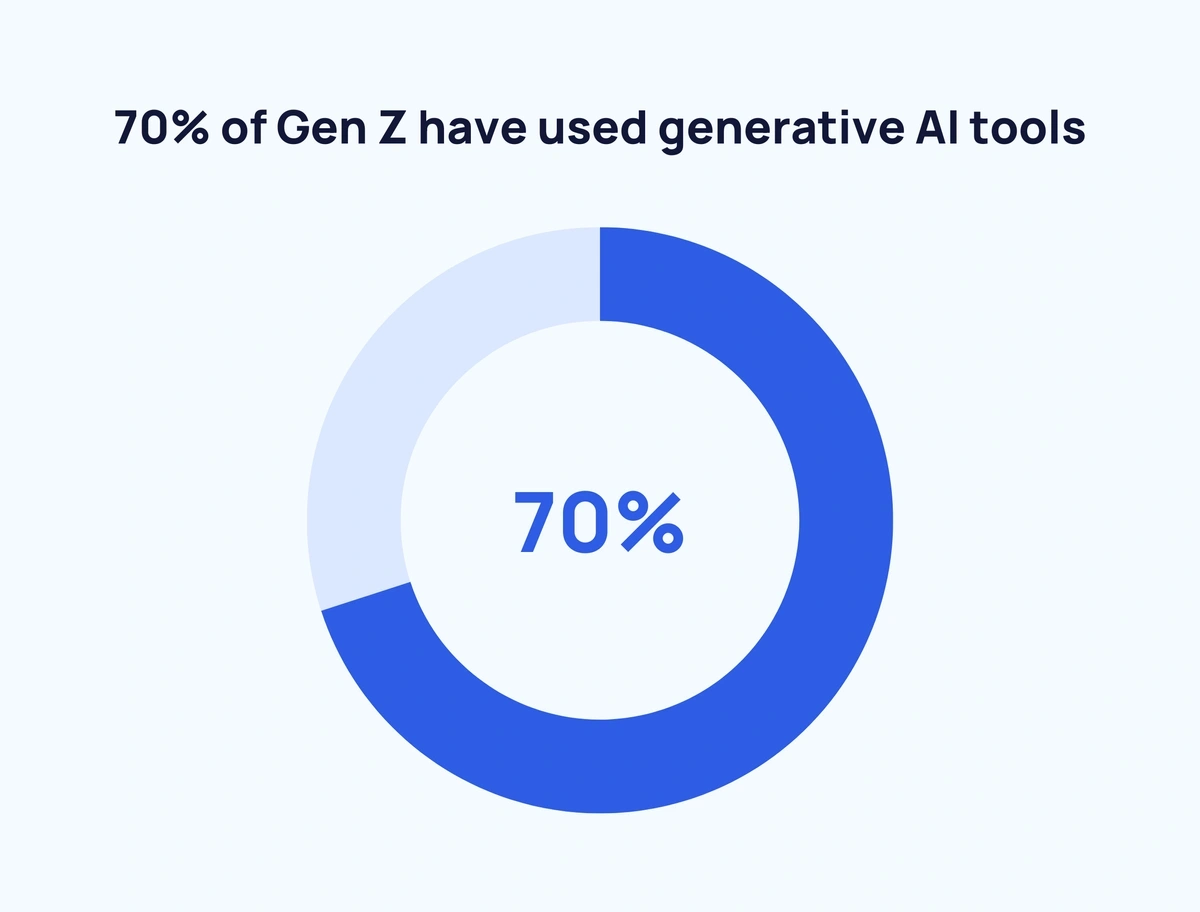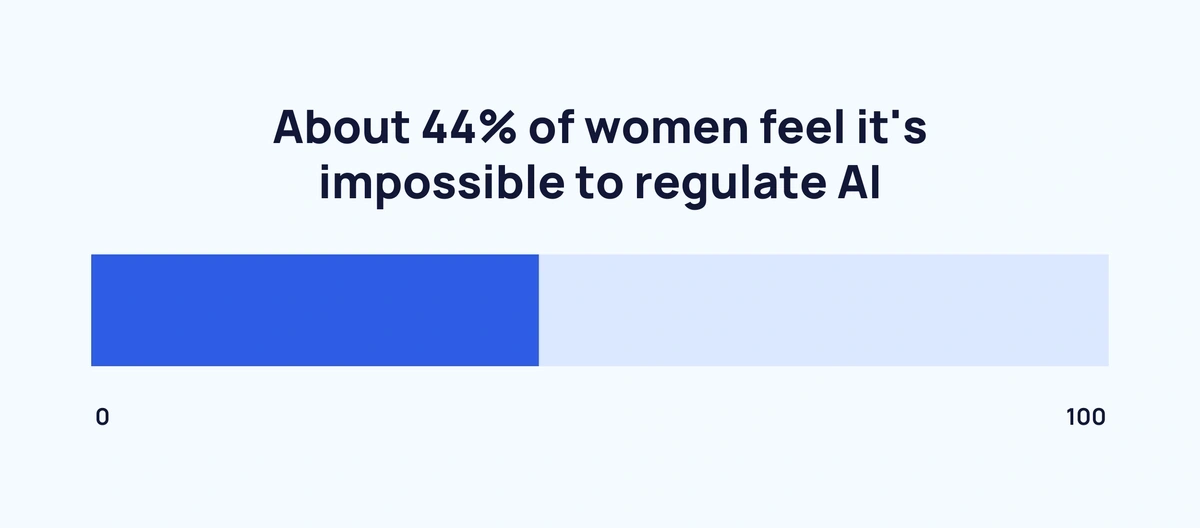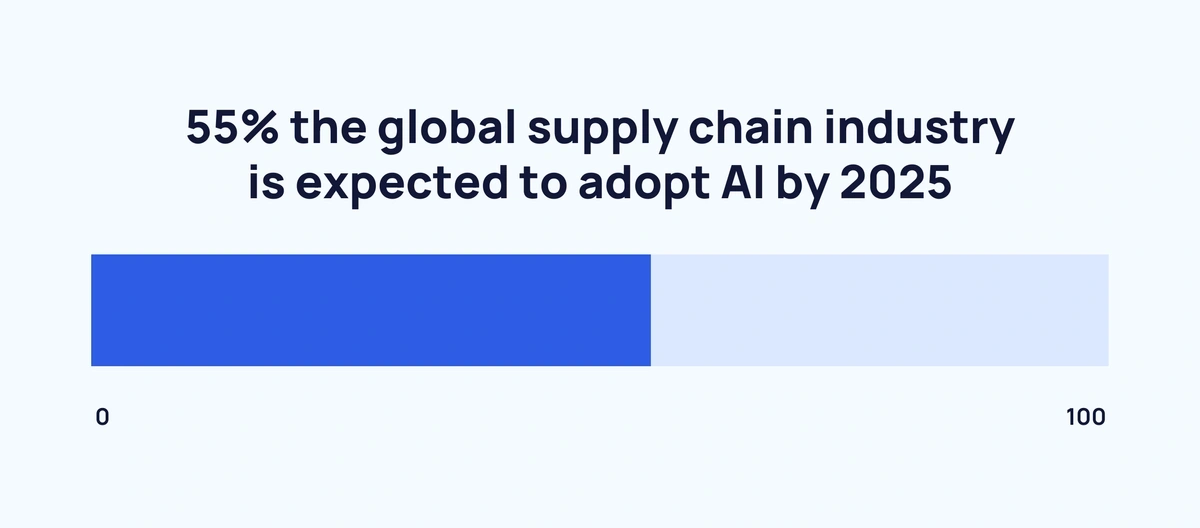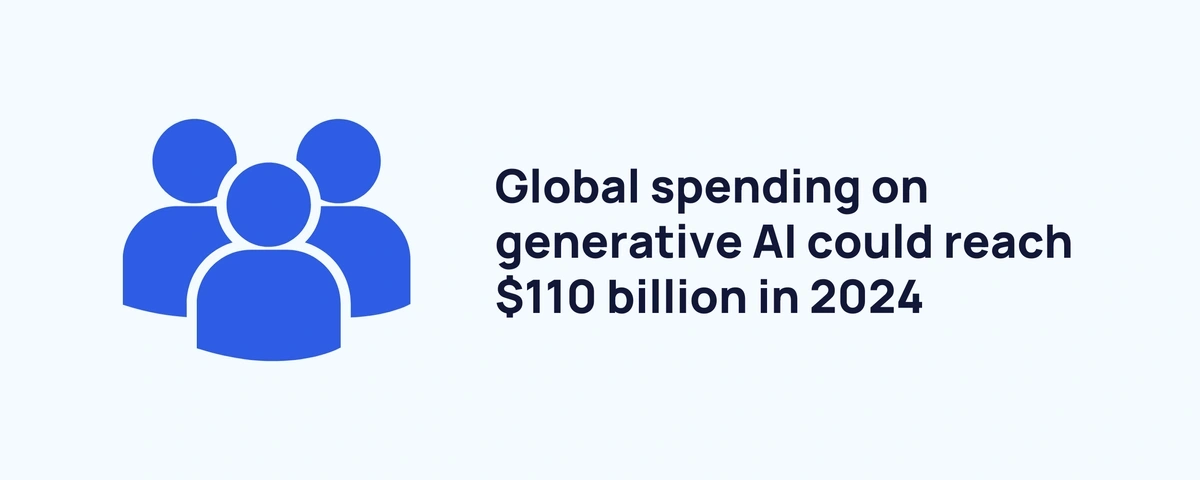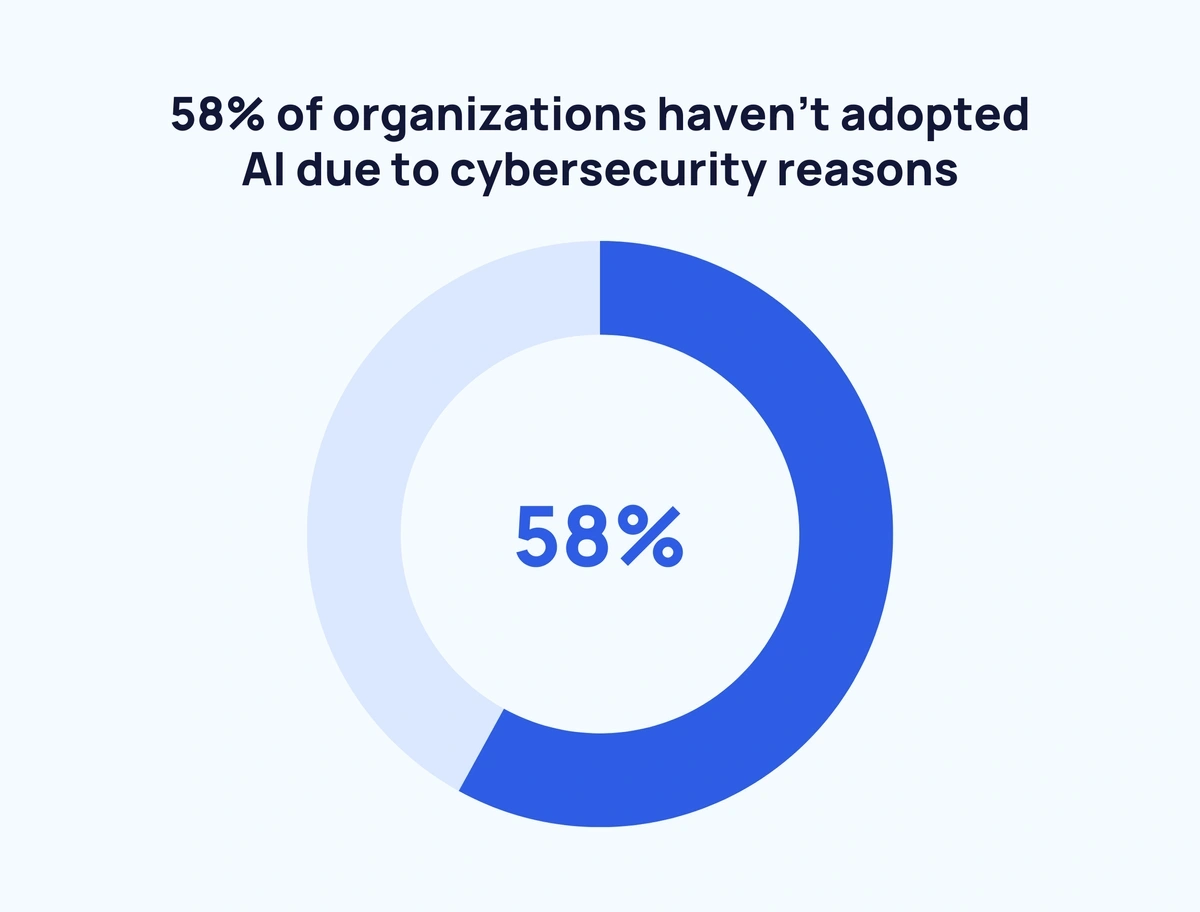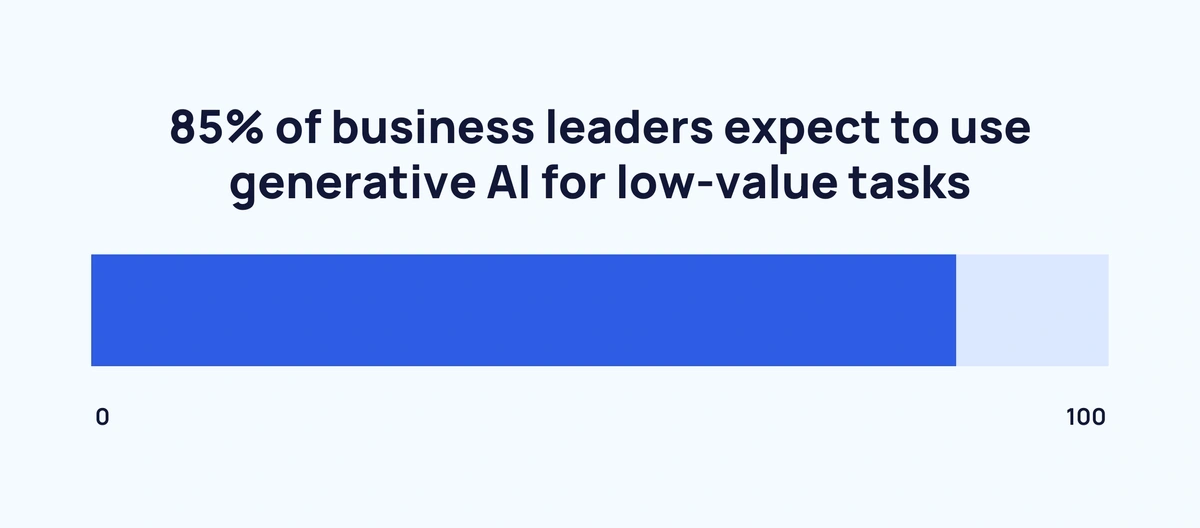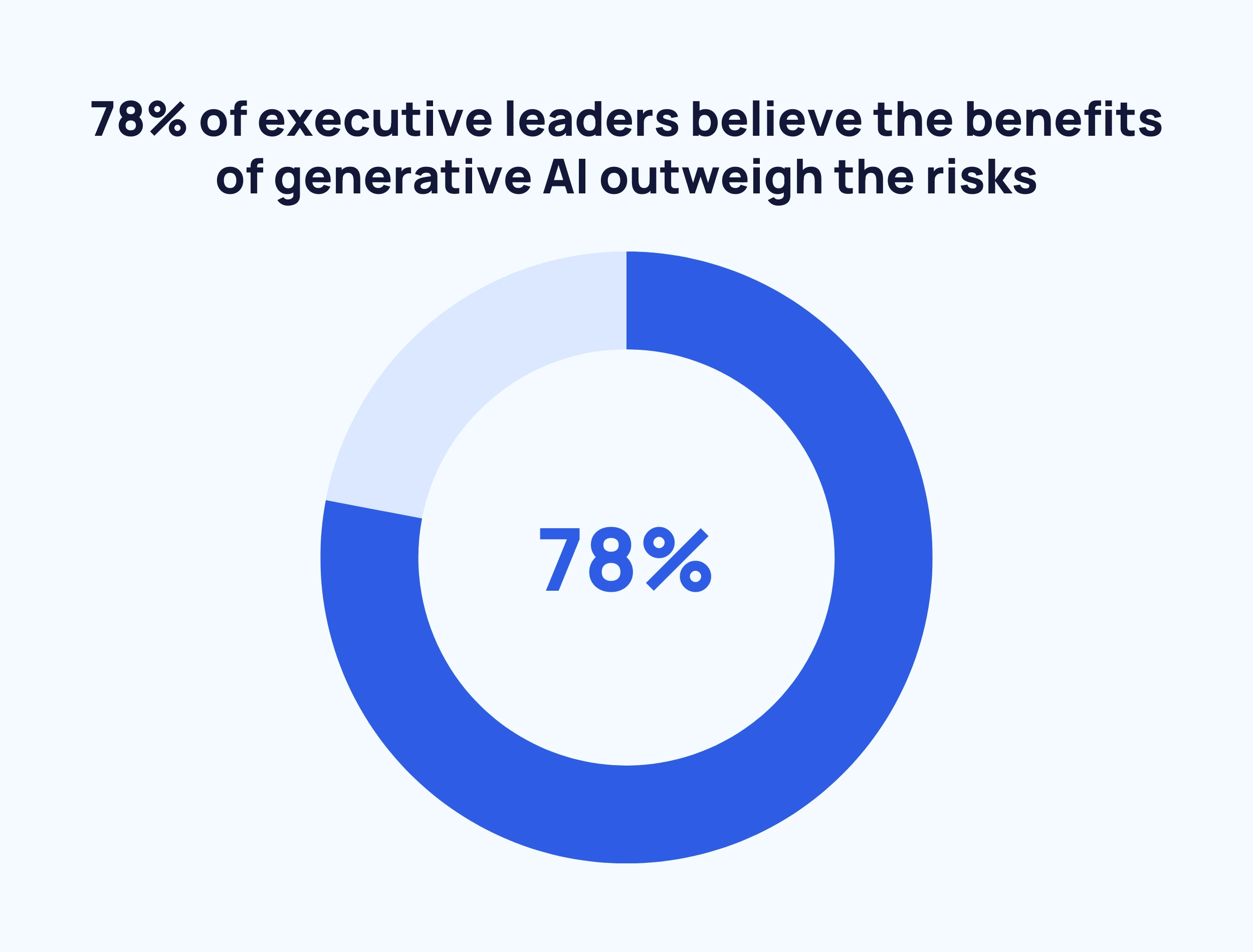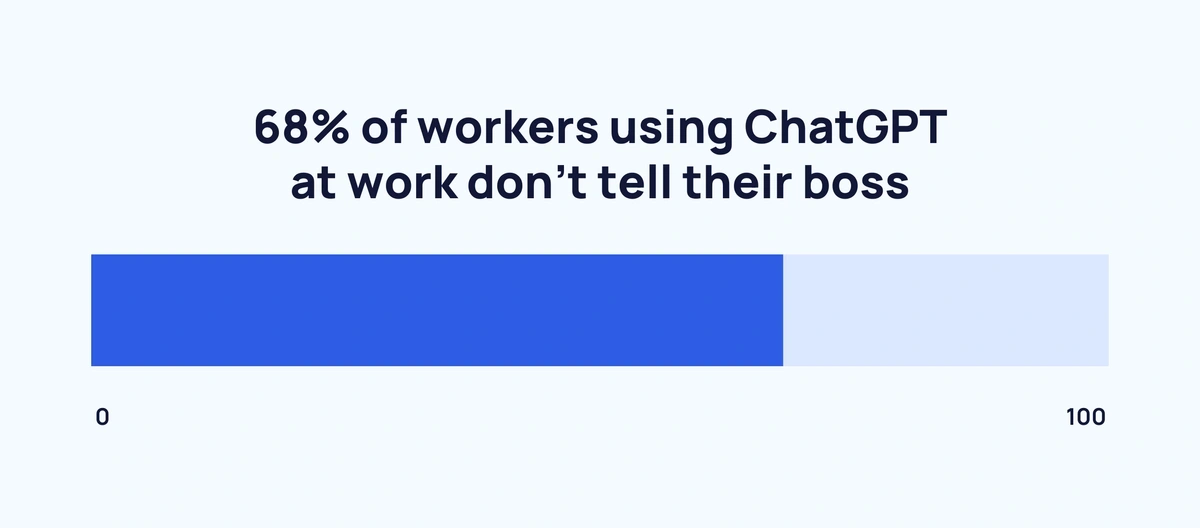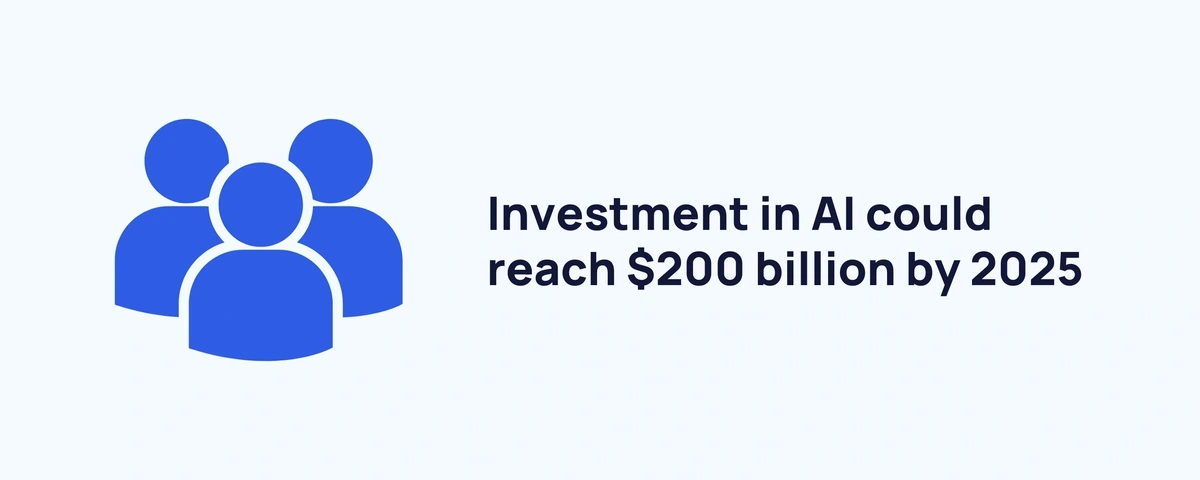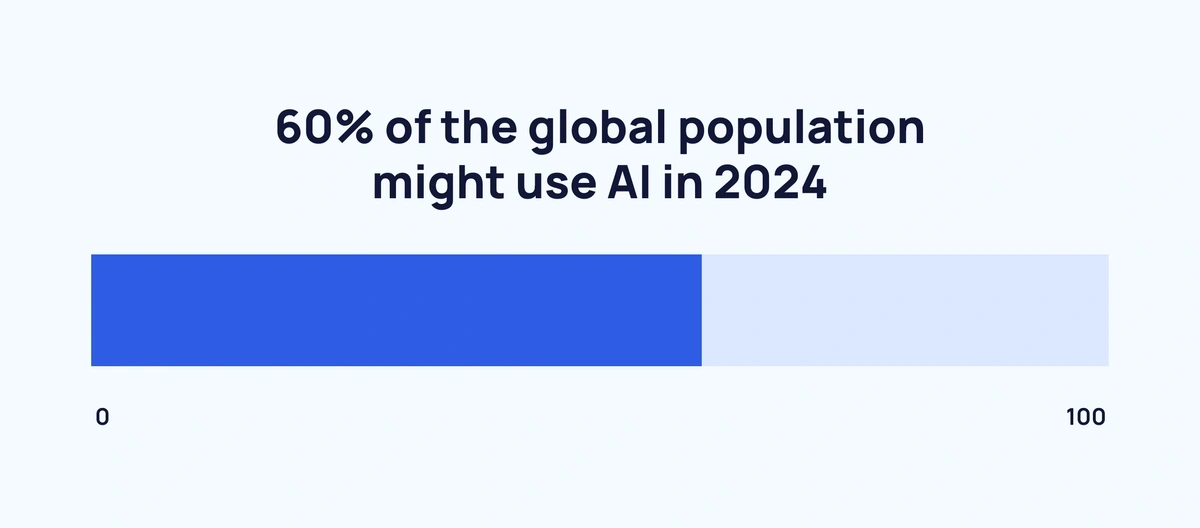
55+ New Generative AI Stats (2025)
This is a comprehensive list of generative AI stats and trends, updated for 2025.
Media deemed last year “The Year of Generative AI”. Bill Gates declared it the most significant technological advance in decades.
But how important is it, really?
These generative AI stats will give you some perspective on what’s happening in the space.
Build a winning strategy
Get a complete view of your competitors to anticipate trends and lead your market
Top Generative AI Stats for 2025
- The global generative market is worth $44.89 billion
- 92% of Fortune 500 firms have adopted generative AI
- 70% of Gen Z have tried generative AI tools
- Nearly 9/10 of American jobs could be impacted by generative AI
- 95% of customer interactions may involve AI by 2025
- 73% of marketing departments use generative AI
- AI could generate up to 97 million jobs by 2025
Generative AI Market Size Statistics
The global generative AI market is currently valued at $44.89 billion (Statista)
The genAI market value was only $29 billion in 2022.
Today? It’s worth approximately $50 billion.
That’s a 54.7% increase from 2022 to 2025.
Notably, ChatGPT was released on November 30, 2022, which helps explain genAI’s meteoric rise in market value over the last 2-3 years.
Today, ChatGPT has over 800 million weekly users. Additionally, ChatGPT gets 4.6 billion monthly visitors according to Semrush data.
The generative AI market is expected to exceed $66.89 billion by the end of 2025 (Statista)
The global generative AI market is expected to reach $66.62 billion by the end of the year. Much of that growth will be driven by the United States, the largest individual market, which is expected to surpass $23 billion by year’s end.
Generative AI could become a $1.3 trillion market by 2032 (Bloomberg Intelligence)
The generative AI space has plenty of room for long-term future growth.
In fact, the space is projected to be worth $1.2 trillion over the next 9 years:
- Infrastructure-as-a-Service (IaaS) could boost genAI software revenue to $247 billion by 2032.
- Digital ads may follow with $192 billion.
- Generative AI assistant software could make $89 billion.
- Under hardware revenue, AI servers might generate $132 billion.
- Conversational AI devices might contribute $108 billion.
- AI storage, on the other hand, may bring an additional $93 billion.
- Lastly, computer vision AI products might make $61 billion.
Demand for generative AI products could yield $280 billion of new software revenue (Bloomberg Intelligence)
A Bloomberg study found that demand for generative AI might expand at a Compound Annual Growth Rate (CAGR) of 42%.
This rapid growth may generate about $280 billion in new software revenue by 2032.
North America leads in GenAI revenue, holding 40.2% of the global share (Grandview Research)
The largest percentage of genAI revenue (40.2%) comes from North America.
This is partly because tech giants like Microsoft, OpenAI, Meta (formerly Facebook), Adobe, IBM, and Google are headquartered in this region.
Generative AI could have an economic impact of up to $7.9 trillion per year (McKinsey)
According to a report by McKinsey, generative AI could have an economic impact of $6.1-7.9 trillion each year. For context, the World Bank estimates that the gross domestic product of the entire world was just $7.33 trillion in 1977.
Get More Search Traffic
Use trending keywords to create content your audience craves.
Generative AI’s Impact on Business
64% of executives want to adopt generative AI (Google)
Google surveyed 50 businesses in the tech space.
The company found that 64% of these businesses want to adopt generative AI.
92% of Fortune 500 companies are using OpenAI’s technology (Financial Times)
Fortune 500 companies are scrambling for a piece of AI technology.
More than 2 million software developers, mostly from Fortune 500 companies, are building on OpenAI’s API.
94% of business executives believe that AI is a key to success in the future (Deloitte)
Deloitte surveyed 2,620 global businesses to find out their thoughts on GenAI.
94% of business executives said AI would boost their businesses in the next 5 years.
44% of businesses said they use this technology for cloud pricing optimization, while 41% for voice assistants, chatbots, and conversational AI.
Generative AI is already being used by 73% of marketing departments (Botco)
Generative AI is widely used in about three-quarters of marketing departments across various businesses.
At 69%, image generation is the most common reason marketers use generative AI.
Other common uses include text creation at 58%, audio at 50%, chatbots at 37%, and coding at 36%.
Businesses adopting GenAI could achieve 15.7% cost savings (Gartner)
In November 2023, Gartner conducted a poll involving 821 businesses.
The study found that businesses could cut costs by 15.7% for the next 12 to 18 months by investing in genAI.
Chatbots help businesses save 2 hours 20 minutes daily on average (HubSpot)
Chatbots are helping businesses focus on tasks that require a human touch, such as escalation management.
HubSpot estimates the time saved by chatbots to be about 2 hours 20 minutes on average.
On the other hand, businesses that use genAI to write responses to customer service requests save 2 hours and 11 minutes a day on average.
AI adoption in businesses may boost productivity by 24.69% (Gartner)
Gartner’s study involving 821 businesses measured the impact of generative AI on productivity.
The conclusion was that such an investment may boost business productivity by about 24.69% in the next 12 to 18 months.
Generative AI and the Labor Force
84% of Americans have jobs vulnerable to automation by generative AI (LinkedIn)
A job is considered “vulnerable” to automation if more than one-quarter of its functions can be automated.
Nearly 10% of US jobs could be at high risk of replacement by generative AI (BLS)
In July 2022, the Bureau of Labor Statistics published an extensive report on the widespread fears that generative AI will decimate the American job market. It found that just under 10% of all jobs could be at risk of automation by 2029, a slight increase from 9.3% in 2019.
However, while the BLS projected a slowdown in growth among these jobs — with some, like surgeons and housekeeping, seeing slight declines — it concluded that there would still be growth. Additionally, the BLS noted that economic conditions meant that “one would expect slower job creation in more recent years regardless of technological advances.
25% of companies are using AI to tackle labor shortages (IBM)
In 2022, IBM commissioned a study of 7,502 businesses around the world. Respondents explained that automating repetitive tasks helped them deal with labor shortages.
Labor shortages shift the balance of power from employers to workers, often allowing employees to negotiate better compensation and working conditions. Therefore, the widespread use of generative AI to reduce the impact of labor shortages could reduce the influence of workers at the bargaining table.
Just 3% of the skills needed for software engineering are resistant to generative AI (LinkedIn)
A LinkedIn report concluded that people skills and specialized skills were the most resistant to automation, because they still need to be performed by actual humans — at least, for now. According to LinkedIn’s research, just 3% of the skills used by software engineers were people or specialized. In contrast, 88% of the skills used by drivers, 89% of those used by oil field operators, and 90% of those used by nurses were people skills and specialized skills, making these jobs particularly resistant to generative AI.
Generative AI might replace 85 million jobs in the world by 2025 (We Forum)
The fear of AI scrapping certain jobs isn’t unjustified.
Key industries with the highest potential for automation include:
- Banking (54%)
- Insurance (48%)
- Energy (43%)
- Capital markets (40%)
- Retail (34%)
- Communications and media (33%)
In total, analysts predict that this technology might make 85 million jobs obsolete by 2025.
AI may create as many as 97 million jobs by 2025 (We Forum)
It’s not all gloom for workers.
While AI might replace 85 million jobs, this could create 97 million jobs by 2025.
Technically, that’s a net job creation rate of 12 million.
Almost all major industries, such as finance, healthcare, technology, media, and marketing, may need skilled AI professionals.
AI and machine learning jobs are expected to grow the fastest in the next 4 years, with bank tellers and clerical roles on the decline (We Forum)
The demand for specialists in AI and machine learning, sustainability, business intelligence analysis, and information security is expected to rise between 2023 and 2027.
Careers AI could wipe out by 2027 include:
- Administrative and executive secretaries
- Accounting, bookkeeping, and payroll clerks
- Security guards
- Building caretakers and housekeepers
- Cashiers & ticket clerks
- Assembly and factory workers
- Postal service clerks
61% of workers use or plan to use generative AI (McKinsey)
Generative AI is now part of the workforce in the US, UK, Australia, and many other parts of the world.
And it’s doing everything imaginable (and sometimes even unimaginable).
From writing content and composing videos to generating code, this technology may automate 30% of hours worked in a day by 2030.
Programmers using generative AI are 88% more productive (Github)
By studying the use of CoPilot, an AI coding assistant, Github determined that programmers were far more efficient when using generative AI. The AI tool allowed programmers to work 15% faster on code reviews, 55% faster overall, and 96% faster on repetitive tasks. Programmers using the AI tool were 85% more confident in the quality of their code.
Generative AI Usage by Demographics
70% of Gen Z have used generative AI tools (Salesforce)
Younger generations seem more interested in genAI than their older counterparts.
In a Salesforce study with 4,000 participants, they found that 70% of Generative AI users were from Gen Z (people born during the late 1990s and the early 2000s).
68% of consumers unfamiliar with genAI are Gen X and Boomers (Salesforce)
A recent survey discovered that 68% of those unfamiliar with GenAI are from Gen X and the Baby Boomer generation.
Of these, 40% don't know much about GenAI.
Another 32% don't find it useful.
Men are 2x as likely as women to use GenAI (Forbes)
One study found that men typically use generative AI tools more than women.
ChatGPT, the world’s most popular genAI platform, had an average of 1.5 billion monthly visits in 2023.
69.5% of those visitors were men, while 30.5% were women.
Men are 7x as likely as women to let their kids use generative AI (Axios)
About 31% of men feel comfortable letting their kids use AI chatbots like ChatGPT “for any purpose.”
It’s a different story with women – only 4% say they would allow their kids to use this technology.
The majority of women feel it’s impossible to regulate generative AI (Axios)
About 44% of women feel it's impossible to regulate AI.
In contrast, only 23% of men think regulating AI is impossible.
Impact of Generative AI Across Industries
AI adoption in retail may expand by almost 8x in 7 years (Facts & Factors)
GenAI adoption in the retail industry may have an annual CAGR of about 39% by 2026.
In the retail industry, AI could help with:
- Customer Relationship Management (CRM)
- Price optimization
- Payment services management
- In-store security and surveillance
- Market forecasting
- Predictive merchandizing
Standing at $2.7 billion in 2019, AI adoption in the retail market may increase by almost 8x in only 7 years.
More than half of the global supply chain industry is expected to adopt AI by 2025 (Statista)
About 55% of the supply chain management industry could lead the AI adoption bandwagon by 2025.
Key industries in the supply chain sector include:
- Manufacturing
- Retail
- Transportation and logistics
- Warehousing and distribution
- Pharmaceuticals
- Food and beverage
- Electronics
- Automotive
- Agriculture
- Textiles and apparel
Note that this industry comprises global leaders like Amazon, FedEx, Apple, Walmart, and Pepsi.
19 out of 20 customer interactions might be AI-assisted by 2025 (AI Business)
The customer service industry is at the forefront of AI adoption.
Servion Global Solutions predicts that by 2025, AI may power about 95% of business interactions.
9 in 10 customer service industry leaders might invest in genAI by 2025 (Deloitte)
Deloitte predicts that by 2025, about 90% of businesses in the customer service industry might harness the power of artificial intelligence.
Currently, more than 74% of organizations in this industry are already testing or deploying customer chatbots.
Global spending on generative AI could reach $110 billion in 2025 (Mint)
Companies across the world have upped their spending on AI technologies.
In 2024, the spending could hit the $110 billion mark.
By the end of 2025, the AI market could be worth $190 billion.
Barriers to Generative AI Adoption
More than half of organizations believe cybersecurity is the biggest barrier to genAI adoption (Searce)
Businesses and organizations that want to adopt genAI have concerns about this technology.
58% of organizations haven’t adopted AI due to cybersecurity reasons.
Meanwhile, 55% of organizations are concerned about data management and governance.
50% of marketers consider training the most significant roadblock to adopting generative AI (Botco)
Half of the 1,000 marketers surveyed by Botco said that the biggest difficulty in adopting generative AI tools is training team members on how to use them. Training was considered more important than cost, privacy and security, the quality of the content produced, and ethical concerns.
Generative AI powered searches currently cost 10x more than standard keyword searches (Reuters/Morgan Stanley)
Google and Microsoft have started integrating generative AI into their search functions. However, the computation required for these AI-assisted search queries is far more intense and expensive than traditional searches. According to Morgan Stanley, if half of Google’s 3.3 trillion annual search queries required generative AI to produce 100 words in response, it would result in a $12 billion cost.
62% of business executives lack the skills to execute their AI strategy (Google)
About 64% of business leaders want to adopt genAI.
However, 62% lack the skills to implement this technology into their business strategies.
35% of companies lack the infrastructure to support AI implementation (Forrester)
Lack of AI skills isn’t the only barrier to genAI adoption.
Forrester discussed this topic with 220 AI decision-makers at North American firms.
35% of the respondents said they lacked adequate infrastructure to support AI data consumption and storage.
Generative AI deepfakes fraud has increased by 1200% in the US (BusinessWire)
There is rising concern over the use of deepfakes since genAI went mainstream in 2023.
In 2020, researchers discovered more than 85,000 deepfake videos.
Since then, the number has doubled every 6 months.
Between 2022 and the first quarter of 2023, for instance, the use of deepfakes in the US grew from 0.2% to 2.6%.
Canada witnessed a 4500% increase in deepfakes usage between 2022 and Q1 of 2023.
27.2% of companies don’t trust generative AI outputs (AI Accelerator Institute)
Understandably, about a quarter of companies don’t trust genAI.
That’s partly because AI models are prone to mistakes.
ChatGPT, for example, can sometimes “hallucinate” and provide inaccurate information.
Generative AI Adoption Rates and Trends
85% of business leaders expect to use generative AI for low-value tasks by the end of 2025 (MIT/Telstra)
Of the 300 business leaders surveyed, 77% expected to implement generative AI for customer service tasks, while 74% planned on using it for analysis.
45% of organizations are piloting generative AI programs (Gartner)
In October, Gartner polled 1,419 executive leaders on their use of generative AI. The 45% who reported piloting generative AI represents a 30-point increase from March and April 2023.
37% of the US marketing and advertising industry has already adopted generative AI (Statista)
As of 2023, the marketing and advertising industry was leading the charge in adopting generative AI. Somewhat surprisingly, it was ahead of the tech industry, of which 35% had adopted generative AI. For comparison, adoption rates were 30% in consulting, 19% in teaching, 16% in accounting, and 15% in healthcare.
86% of IT leaders expect generative AI be important to their company in the near future (Salesforce)
Salesforce’s 2023 State of IT report revealed an overwhelming expectation that generative AI would soon be a vital part of IT organizations. Meanwhile, 58% of IT leaders surveyed by Salesforce said they were unsatisfied with the level of automation their organizations had currently implemented. Fortunately, 87% believed their organizations would increase investment in automation over the next year and a half.
78% of executive leaders believe the benefits of generative AI outweigh the risks (Gartner)
The more than three-quarters of executive leaders who expressed positive sentiment towards generative AI in Gartner’s October poll represents a significant increase from March and April 2023, when 68% of leaders said they thought generative AI’s benefits outweigh its risks.
Only 6% of financial businesses have not used AI at all (Statista)
According to a report released in November 2023, well over 90% of financial businesses had at least piloted use cases for AI by 2022. Just under half had implemented adoption on a wide scale, and a quarter had adopted AI on a limited basis. Only 8% of financial businesses had integrated AI into a critical part of their operations, but that number is expected to rise significantly over the next few years.
69% of marketers use generative AI for image creation (Botco)
Perhaps unsurprisingly, image creation is by far the most popular use case for generative AI among marketers. 58% of marketers used generative AI for text creation, 50% for audio or voice creation, and just 36% for coding.
68% of workers using ChatGPT at work don’t tell their boss (Fishbowl)
In 2023, Fishbowl surveyed 11,793 professionals from companies like Amazon, Google, and Meta. 43% of them — over 5,000 — reported using AI tools to assist with their work tasks. But of those 5,000, just 32% were doing so with their boss’ knowledge (and, presumably, approval).
The term “AI” was mentioned 895% more often on earnings calls in the final quarter of 2023 than in the final quarter of 2022 (S&P Global)
In Q4 2023, 159 S&P 500 companies collectively used the term AI 2,398 times in their earnings calls. In comparison, the year before the term was collectively mentioned just 241 times by 52 companies.
Investment in Generative AI
Private equity investment in generative AI increased by 118% from 2022 to 2023 (S&P Global)
In 2022, private equity firms invested $1 billion in generative AI across 35 deals. In 2023, there were just 22 deals, but they represented $2.18 billion in investment into generative AI, a significant increase that defied a broad decline in mergers and acquisitions backed by private equity.
Total investment in generative AI increased by 407% from 2022 to 2023 (CB Insights)
After a decline in the amount invested into generative AI from $9.9 billion in 2021 to $4.3 billion in 2022, 2023 saw investment skyrocket to $21.8 billion across 426 individual deals. Companies working on generative AI infrastructure received 77.5% of total investment.
Investment in AI could reach $200 billion by 2025 (Goldman Sachs)
Researchers noted that significant investment would likely come before generative AI started having significant effects on productivity.
43% of US companies generating at least $1 billion annually plan to invest $100 million or more in generative AI (KPMG/WSJ)
KPMG surveyed 220 companies to arrive at this stat. As KPMG’s technology consulting leader explained, companies “don’t fully appreciate all the benefits yet.” However, “in the spirit of the unknown, organizations are taking a leap of faith.”
Generative AI Future Projections
90% of online content might come from generative AI by 2026 (Europol)
The AI adoption rate in online content creation might peak in 2026.
Adopting AI in workplaces could help streamline workflows and eliminate repetitive tasks.
However, there are concerns that AI adoption might lead to efficient content creation but not necessarily higher quality content.
GenAI’s annual global GDP might match or surpass 6 of the G8 countries (McKinsey)
GenAI is projected to add up to $4.4 trillion annually to the global economy, which currently stands at about $105 trillion.
That’s an estimated annual contribution of 4.2%.
For perspective, 6 of the G8 countries, namely Germany, Canada, France, Italy, Russia, and the United Kingdom, did not contribute more than 4.2% to the global GDP in 2022.
Among the G8 countries, only the United States (25%) and Japan (4.2%) contributed more than 4.2% to the global GDP in 2022.
AI might develop 15% of new applications without human intervention by 2027 (Gartner)
Currently, application development requires some level of human intervention.
But that could change in the near future.
According to Gartner, AI may build 15% of new applications from scratch with no human intervention.
More than half of the global population might use AI in 2025 (Forrester)
GenAI could become a part of our daily lives.
In 2024 alone, 60% of the world’s population may interact with this technology – knowingly or unknowingly.
Conclusion
That wraps up the top generative AI stats of 2025.
It’s impossible to ignore AI’s potential impact for the future.
(Whether these predictions will come to pass remains to be seen).
For now, it’s clear that AI in general is likely going to disrupt several different industries.
If you’d like to learn more about the current state of artificial intelligence and machine learning, check out our regularly-updated collection of AI statistics and this list of fast-growing AI companies.
Stop Guessing, Start Growing 🚀
Use real-time topic data to create content that resonates and brings results.
Exploding Topics is owned by Semrush. Our mission is to provide accurate data and expert insights on emerging trends. Unless otherwise noted, this page’s content was written by either an employee or a paid contractor of Semrush Inc.
Share
Newsletter Signup
By clicking “Subscribe” you agree to Semrush Privacy Policy and consent to Semrush using your contact data for newsletter purposes
Written By


Josh is the Co-Founder and CTO of Exploding Topics. Josh has led Exploding Topics product development from the first line of co... Read more


